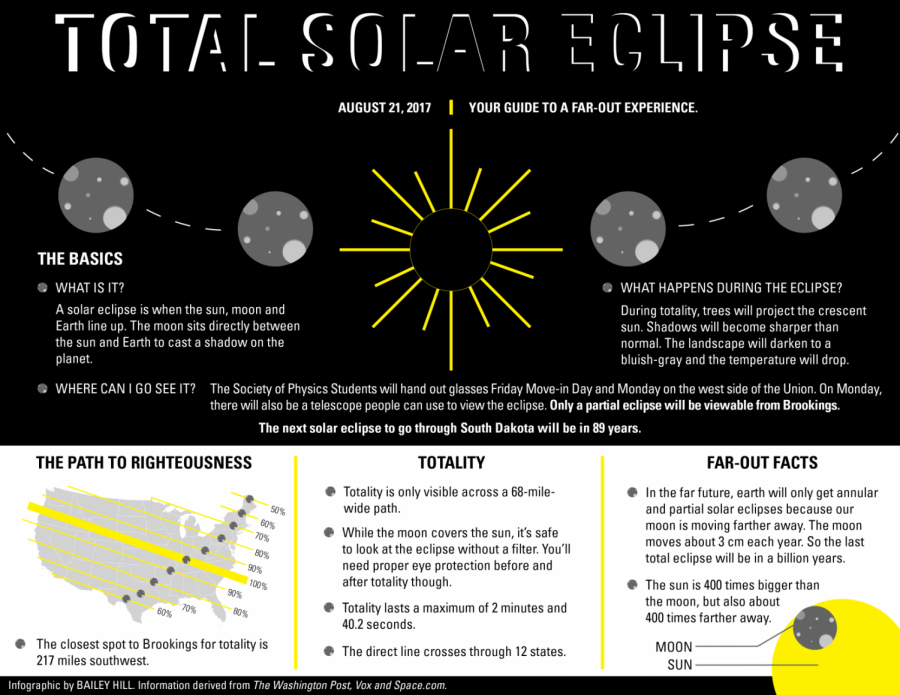Brookings tips for the Great American Eclipse
August 17, 2017
Like any good astronomy professor, Judy Vondruska is playing hooky on the first day of class to see the “Great American Eclipse” in totality. But with permission from the physics department head and dean of the College of Arts and Sciences, of course.
Monday’s eclipse will be Vondruska’s second total solar eclipse.
The most striking memory of her first total solar eclipse in 1991 was of hundreds of birds flying off an island on the Mexican coast — spooked by the sudden darkness caused by the moon’s shadow.
That kind of experience should be on everyone’s bucket list, Vondruska said.
Although the closest spot to Brookings where the eclipse can be seen in totality is 217 miles away, students can still see a similar spectacle from campus.
About 90 percent of the sun’s surface will be covered by the moon in a partial solar eclipse in the Brookings area. The Society of Physics Students will hand out free eclipse glasses to students Friday, Aug. 18 and Monday, Aug. 21, the day of the eclipse, so students can view the astronomical phenomenon.
Club members plan to hand out the glasses near the west side of the Student Union entrance and will provide a dobsonian telescope with a solar filter to give students a clearer view. The eclipse itself will happen between 11:30 a.m. and 2:30 p.m. on Monday.
“I’m excited because this rarely happens — just once in our lifetime,” said Kyle Schroeder, senior physics major and president of the Society of Physics Students. “That’s a big deal. It’s a cool way to kick off the year.”
{{tncms-asset app=”editorial” id=”547a99ac-8419-11e7-90e4-aff9f0eefa44″}}
Solar eclipses can happen two or three times a year, but they’re usually only visible from a small area on Earth. That makes this eclipse a little more special, according to Vondruska.
“To have one that crosses the entire United States hasn’t happened in a century, so that’s incredible for people to get to see,” Vondruska said.
Various partial eclipse phases can be seen everywhere within the continental United States. The path of the total eclipse will travel through 12 states.
During the partial eclipse in Brookings, students will see a noticeable difference in daylight, the sky will turn a little bluer and there will be a drop in temperature.
Although students may miss out witnessing the eclipse in totality because of the first day of the semester, Vondruska believes it’s a sight everyone can appreciate.
“We won’t have another opportunity like this until 2024 and that partial eclipse won’t be as good as this one,” Vondruska said.
The next time a total solar eclipse will cross South Dakota isn’t until the 22nd Century. Everyone can mark their calendars for May 3, 2106.
If the Society of Physics Students runs out of eclipse glasses, they’re available for purchase at Lowe’s and Walmart.
























